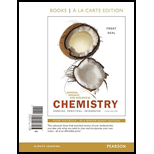
Concept explainers
a.
To explain:
The reaction
Introduction:
Glycolysis is the first step in the
b.
To explain:
The reaction glucose-
Introduction:
Glycolysis is the first step in the cellular respiration and is a common step in both aerobic and anaerobic organisms. It involves set of ten reactions, which catalyzes the breakdown of glucose sugar. After glycolysis, one molecule of glucose yields two molecules of pyruvate, two molecules of ATP (adenosine triphosphate) and two NADH (nicotinamide adenine dinucleotide) molecules.
c.
To explain:
The reaction phosphoenolpyruvate to pyruvate produces ATP or NADH.
Introduction:
Glycolysis is the first step in the cellular respiration and is a common step in both aerobic and anaerobic organisms. It involves set of ten reactions, which catalyzes the breakdown of glucose sugar. After glycolysis, one molecule of glucose yields two molecules of pyruvate, two molecules of ATP (adenosine triphosphate) and two NADH (nicotinamide adenine dinucleotide) molecules.
Want to see the full answer?
Check out a sample textbook solution
Chapter 12 Solutions
General, Organic, and Biological Chemistry, Books a la Carte Edition (3rd Edition)
- 1. In which steps are ATP produced in glycolysis and how many ATPs are produced in the glycolysis of glucose molecule (Show the computations). ? 2. Show how the ATP is computed in the glycolysis process.arrow_forward1a) Under aerobic conditions, what is the net production of ATP under glycolysis? a. 2 ATP b. 4 ATP c. 36 ATP d. None of the above 1b). What reaction occurs when NAD+ is converted to NADH + H+? a. Hydrolysis b. Oxidation c. Reduction d. Phosphorylatioarrow_forwardConsidering the individual steps in glycolysis: a. Which steps form ATP? b. Which steps use ATP? c. Which steps form a reduced coenzyme? d. Which step breaks a C C bond?arrow_forward
- When one glucose molecule undergoes glycolysis, it generates net _____ ATP and ______NADH.arrow_forwardHow many moles of ATP can be synthesized from ADP using the 500. Calories ingested during a fast-food lunch? How many molecules of ATP does this correspond to?arrow_forwardHow many molecules of ATP are obtained from complete (including the fourth stage of catabolism) metabolism of one molecule of glucosearrow_forward
- Although catabolism of a glucose molecule eventually produces a lot of energy, the first step uses energy. Explain why this step is necessaryarrow_forwardHow many ATP molecules are used and produced per molecule of glucose during glycolysis?arrow_forwardHow many moles of ATP would be formed from 10.5 moles of NADH and 6.75 moles of FADH2 during electron transport and oxidative phosphorylation?arrow_forward
 General, Organic, and Biological ChemistryChemistryISBN:9781285853918Author:H. Stephen StokerPublisher:Cengage Learning
General, Organic, and Biological ChemistryChemistryISBN:9781285853918Author:H. Stephen StokerPublisher:Cengage Learning Organic And Biological ChemistryChemistryISBN:9781305081079Author:STOKER, H. Stephen (howard Stephen)Publisher:Cengage Learning,
Organic And Biological ChemistryChemistryISBN:9781305081079Author:STOKER, H. Stephen (howard Stephen)Publisher:Cengage Learning, Chemistry for Today: General, Organic, and Bioche...ChemistryISBN:9781305960060Author:Spencer L. Seager, Michael R. Slabaugh, Maren S. HansenPublisher:Cengage Learning
Chemistry for Today: General, Organic, and Bioche...ChemistryISBN:9781305960060Author:Spencer L. Seager, Michael R. Slabaugh, Maren S. HansenPublisher:Cengage Learning- Chemistry: Matter and ChangeChemistryISBN:9780078746376Author:Dinah Zike, Laurel Dingrando, Nicholas Hainen, Cheryl WistromPublisher:Glencoe/McGraw-Hill School Pub Co



